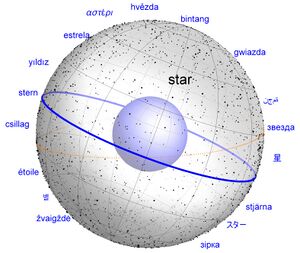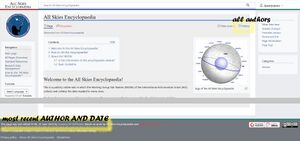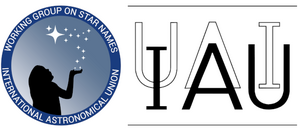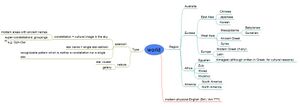All Skies Encyclopaedia
Welcome to the All Skies Encyclopaedia!
This is a publicly visible wiki in which the Working Group Star Names (WGSN) of the International Astronomical Union (IAU) collects and collates the data needed to name stars.
Modern star names are used in research papers; they are supposed to be a convention for global communication undertaken in English. The names of the IAU-Catalog of Star Name will never replace the names of local traditions and cultural heritage.
How to cite this encyclopaedia
This encyclopaedia is created by researchers who should be acknowledged: CC-BY licence, see footer.
There are two version of citation:
- simplest possible for the acknowledgement in a paper: please state "For our research we thankfully made use of the All Skies Wiki by the IAU WG Star Names."
- If you directly quote passages from a specific page, please treat it like a book: After your cited statement, please provide the reference in the conventional format (e.g., author, year). The authors of the specific page are written in the "history" (button at the top) and the year is taken from the bottom the page where it is written "...last edited on ..." which refers to the specific page (not to the whole encyclopaedia).
Citation Form
[Author Name] [date/ year], [Title of Page (entry)], in: All Skies Encyclopaedia of the IAU
About IAU WGSN
Astronomy is a rather old science practiced by all cultures on Earth. Therefore, modern astronomy & astrophysics for a long time hesitated to name stars at all. For any bright (naked eye) star, there are different names in all cultures. It was only because of the nomenclature of variable stars (they are named with a number and the constellation name) and research on variables as an emerging field in the early 20th century that the young IAU in the 1920s aimed to define the names and boundaries of constellations officially, globally binding for use in international communication in research. However, back then, they did not officially define any star names. Only in the early 2000s with yet another emerging field in astronomy, i.e. the research on extrasolar planets, the necessity for global agreements on “scientific names” for stars evolved. These are the names that shall be used in research papers – but of course, all planetariums, school teachers and hobby astronomers will (hopefully) keep their local traditions in addition. We encourage everybody to keep their own cultural heritage!
As a newly established working group of the IAU (established only in 2016) we have developed two branches: The branch of research on cultural heritage and historical names for the bright stars with which we now aim to name the bright stars (facing a lot of cultural struggles, as we want to include everybody and don’t want to be intrusive), and the other branch of naming faint stars (invisible to the naked eye observer) with all sorts of names suggested by the public – which can be names of local cultures, global pop culture or anything else…
As we are a rather young working group within the IAU and still in the process of updating our terms of reference while we are faced with new suggestions, it may take a while until a specific star is named.
Is the information in this encyclopaedia reliable?
The information presented in this encyclopaedia is 100% human-generated (not AI-generated) and entered by a selected group of researchers to the best of their knowledge (like in books). Researchers of astronomy collaborate in the framework of the International Astronomical Union. When we enter the information here, we refer to reliable researchers' scientific publications and explicitly give references.
Due to copyright issues, we cannot copy all books. However, we will summarize the information and refer to the original publication(s), where you can read all arguments in their completeness.
Basic Guideline
- The Encyclopaedia compiles published research comprensively. It is not a means to publish new ideas. However, it might be a means to published more images, colour images, animated images, movies, and other material that could not be published in the original research papers.
- Sources (published research) are linked by the authors.
- Each entry in this encyclopaedia must have at least three categories for
- the geographical region on Earth
- the language of origin
- the nature of celestial object or phaenomenon behind the name.








